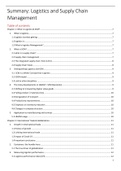Resume
Summary Logistics & supply chain management IBM1
- Établissement
- Arteveldehogeschool (Artevelde)
Full summary of the course Logistics & supply chain management given by Simon van Beveren in the first year of IBM. Normaly a 2nd semester course, this summary is of the same course given in the 1st semester. The content is the same and contains everything needed for the exam. Summary is based on t...
[Montrer plus]




